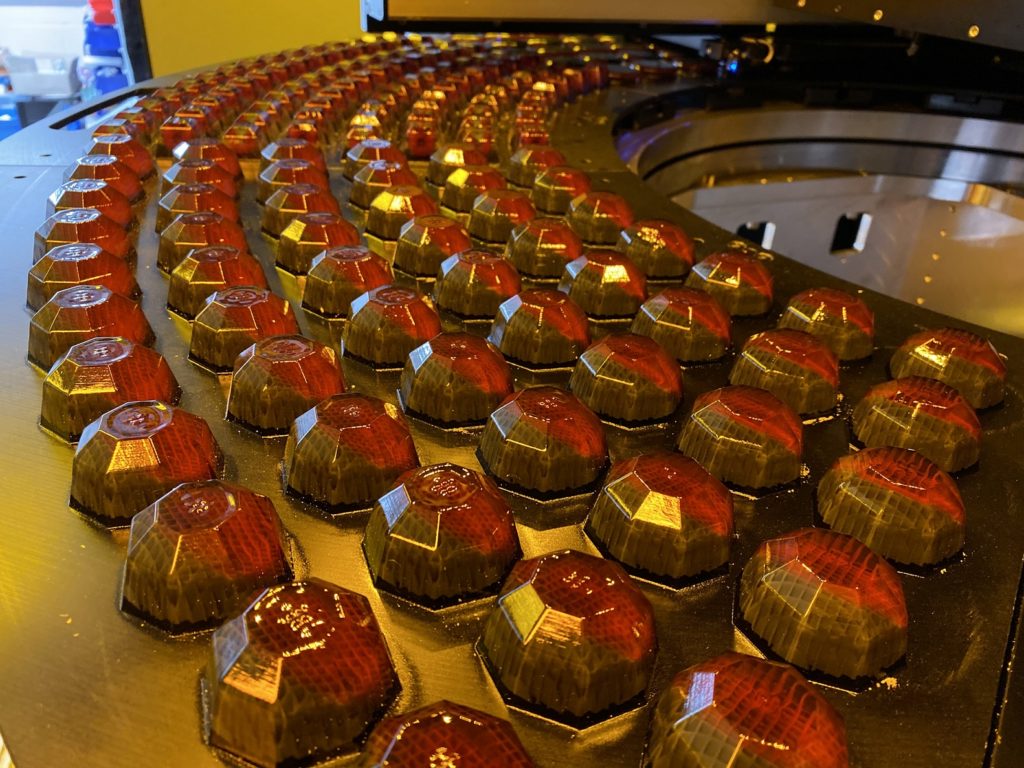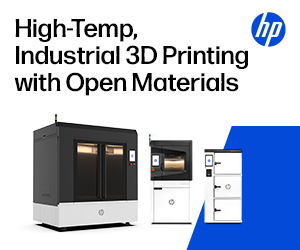Xaar is an inkjet head manufacturer. Xaar3D is its 3D printing subsidiary, 45% of which is owned by Stratasys, and XaarJet commercializes inkjet heads for applications including 3D Printing. Xaar and its subsidiaries have chosen a quixotic but so far effective path into the 3D printing market. The U.K.-based maker of drop-on-demand industrial piezoelectric inkjet printheads, offers its inkjet heads to inventors and engineers who are developing 3D printing technologies. It does so in a much more open and accessible way than peers. It also has technical resources available to aid people in this development.
By not attempting to only enter directly, as HP does, or to tie itself to selling inkjet heads directly to OEMs, as Ricoh does with Stratasys, Xaar is trying to catch the next wave. Rather than one main effort of its own, it has spread betting on the ingenuity of many others. This has lead to its technology being used in personalized pharmaceuticals, for example. The company has a five-step evaluation plan to help guide potential inkjet 3D printing projects and we detail its open printhead approach here. Meanwhile, Xaar is also putting a lot of effort into the HSS technology to perhaps additionally score a hit technology as well.

One open printhead customer is dp Polar. German dp Polar is an industrial 3D printing OEM that makes the innovative AM Polar i2. This machine uses High-Speed Rotative AM (HSR) to spin a print platform onto which it can jet up to 10 liters an hour of CubicInk material. It is a photopolymer jetting process (think 3D Systems MultiJet and Stratasys Polyjet) combined with a rotating platform. The specialty photopolymer resins are made by Altana, a $2 billion revenue German specialty chemicals company that has invested in dp Polar.
Through rotating the platform and using single pass jetting, dp Polar is potentially developing a high throughput technology capable of producing many small individualized parts. What’s more, it has a water-soluble support material and could be used to jet multiple materials or gradient parts. The rotating build volume is also very large coming in at 2.0 m2 , which could be ideal for high yield applications. At the same time, the company’s process allows you to pick and place items in the build during the print. This is difficult to do with SLA and DLP technologies, like those dp Polar directly competes with.

Currently, many manufacturers in dental aligners are tightly wedded to their 3D Systems iPros, while the hearing aid people seem content with Perfactories. There isn’t a lot of pressure on these parties to switch. But, in cases of combinatory manufacturing where electronics are combined with 3D printing, dp Polar’s technology makes a lot of sense.
Photopolymer jetting is limited because there has traditionally been a lot of UV degradation, increased brittleness, and a lack of strength and heat deflection in jetted parts. PolyJet and MJP have, therefore, been used mainly for prototypes and most frequently for visual ones at that. Support removal is often problematic and these technologies have only really been deployed for production in lost wax casting applications. We have seen a lot of improvements in photopolymers over the years in both thermally post-cured materials (that may have increased safety issues) and standard materials cured by UV alone. The advantage of dp Polar’s approach is that the technology is not really suited for large beautiful visual objects. Indeed, this from the ground up has limited itself and in so doing focused its application area.

For certain families of parts that are relatively small and high value, that do require supports, where smoothness is an issue and especially when in-layer pick-and-place could be an advantage, dp Polar will be the natural choice. Altana unit Elantas already makes printed electronics materials. Think of the possibilities in embedded sensors, IoT sensors, or lab-on-a-chip applications. There we could see this technology make a significant number of parts, perhaps with electronics inside of them already. Good luck trying to do that in.an SLS machine, and good luck trying to get the same surface finish from FDM. Photopolymers with their photoinitiator and sometimes other irritants can be problematic for skin contact applications and also could be problematic for production staff. But, if we develop safer processes and materials closer to human applications are also possible. Whereas SLS has always been all things to all men, I see dp Polar’s technology as fitting very specific manufacturing needs precisely.
One of the company’s customers uses the AMpolar i2 to make 500,000 “automotive electronic power-plugs per year at the lowest costs per part” according to the dp Polar press release. Since members of the Klatten family own Altana and also have significant stakes in BMW, the firm can easily leverage an unparalleled network in automotive. Having said that its probably not BWM making power plugs but someone like Bosch, ZF, Continental, Aptiv or Denso that would manufacture something like that (or perhaps a Tier 2/3 supplying them).
Founder of dp Polar Hans Mathea, said, “The AMpolar i2 delivers unparalleled output of printed parts per hour, resulting in a significant reduction in cost per part. The Xaar 1003 is integral to the machine’s design and performance and the ability to handle multiple fluids means that 3D Printing and Additive Manufacturing are now a reality for the volume production of parts for many industries.”
Mike Seal, Xaar’s Business Development Manager, Advanced Manufacturing and 3D Printheads said;
“dp polar’s use of the Xaar 1003 printhead and the innovative design of the AMpolar i2, shows the natural progression of photopolymer jetting from a prototyping technology to a true manufacturing process; a transition we are seeing more and more within functional inkjet applications.”
The Xaar 1003 is a High Laydown single pass drop-on-demand industrial piezoelectric inkjet printhead meant for industrial continuous manufacturing applications. Standard, it comes with 60 print heads and a thousand nozzles. The AMX 1003 was released in 2017 and includes a fluid control optimized AMp version, as well as a ceramics variant.
I asked dp Polar Managing Director Florian Loebermann what applications he sees for the technology. He felt that “the AMpolar i2 is capable of delivering for a truly diverse range of manufacturing applications. From aerospace and automotive through to general manufacturing and machine building, we can now address the serious production of volume parts and at a significantly reduced cost.” He says that “the Xaar 1003 is integral to the machine’s design and performance and the ability to handle multiple fluids means that 3D Printing and Additive Manufacturing are now a reality for volume production from one machine.”
“This capability to deliver volume is further enhanced by the capacity take a hybrid approach to manufacturing. This allows users to think beyond the production of single parts, that may have been previously limited due to their method of manufacture, and realize a new level of agile manufacturing.”
For what types of parts is it best suited?
The AMpolar i2 can make large or small components using multi-materials, such as rigid and flexible polymers. This, combined with the ability to integrate discreet components into the parts within the process, provides a real hybrid approach to manufacturing that is only just starting to be explored.
We always take a system approach to understanding each application. By defining the material and knowing the capability of the Xaar 1003 printheads, we ensure we have a solution tailored to the customer’s requirements.
Won’t material jetting always be limited in part strength and heat?
No, it won’t. Material development is a fundamental part of each customer’s solution as we work with speciality chemicals partners such as ALTANA and BASF to define the specific material properties required for each application.
Inkjet’s ability to handle multiple fluids, allows us to develop materials to meet the unique requirements of each part’s design and is therefore a key advantage to the AMpolar i2. With this multi-material capability, we can emulate materials from traditional manufacturing by combining jetted materials in a smart way, bringing the exact properties into the part where they are needed.
Strength and heat resistance requirements within a part can therefore be varied, meaning we no longer have to think solely in terms of the performance characteristics of one material, thanks to the ability to combine multi-materials.
The ability to jet High Viscosity and Ultra High Viscosity materials with Xaar’s printheads, means many new materials can now be evaluated and used, improving the range of characteristics available for functional parts.
What materials can you print?
The AMpolar i2 is equipped with three individual print stations to process multi-materials efficiently and with high productivity. By working in close collaboration with material suppliers, we offer high-performance print materials that deliver the properties required for each specific application.
By combining the capabilities of the AMpolar i2 together with customised materials we ensure we deliver the part performance demanded at volume and at the cost required.
Do you see electronics picked and placed inside as a key advantage to your technology?
The AMpolar i2 can combine the printing process with other manufacturing workflows such as the picking and placing of electronics. This ability to take a hybrid approach to manufacturing removes barriers to the design of parts which no longer need to be viewed as single, discrete components and is therefore a key advantage to the machine.
As materials develop and software is created to further access these design and process capabilities, the use across different applications will become much more prominent. All it needs is the right visionary end user to recognize it!
It would be interesting to see if dp Polar could leverage its technology to bringing the industry a new party to mass or mass-customized manufacturing. Especially when printing on existing parts or with added pick-and-place parts, dp Polar would seem to occupy a niche that could have them make millions of parts for a diverse customer group.
Subscribe to Our Email Newsletter
Stay up-to-date on all the latest news from the 3D printing industry and receive information and offers from third party vendors.
Print Services
Upload your 3D Models and get them printed quickly and efficiently.
You May Also Like
ASTM International Works with UK MoD on America Makes Project
The UK Ministry of Defense (MoD) will work with ASTM International on a $1.1 million project to let it work in closer concert with the US Department of War (DoW)....
UK Government Funds Research to Develop 3D Printed Metal Alloys for Nuclear Fusion
The UK Atomic Energy Authority (UKAEA), a government-funded research organization, has demonstrated a persistent interest in developing metal additive manufacturing (AM) materials for nuclear fusion applications, including multiple phases of...
Top 10 3DPrint.com Stories of 2025: Kickstarter, Consumer Goods, Bankruptcy, & More
As Vanesa Listek wrote, last year was a major turning point for additive manufacturing (AM), as the industry is working to sort itself out. Customers want proven use cases and...
3D Printing Predictions 2026: Industrial Production & Polymer Additive Manufacturing
Polymer additive manufacturing is seeing less investment, attention, and disruption than metal additive manufacturing currently. Less crucial for defense needs, it has of late had far fewer new entrants. But,...





























